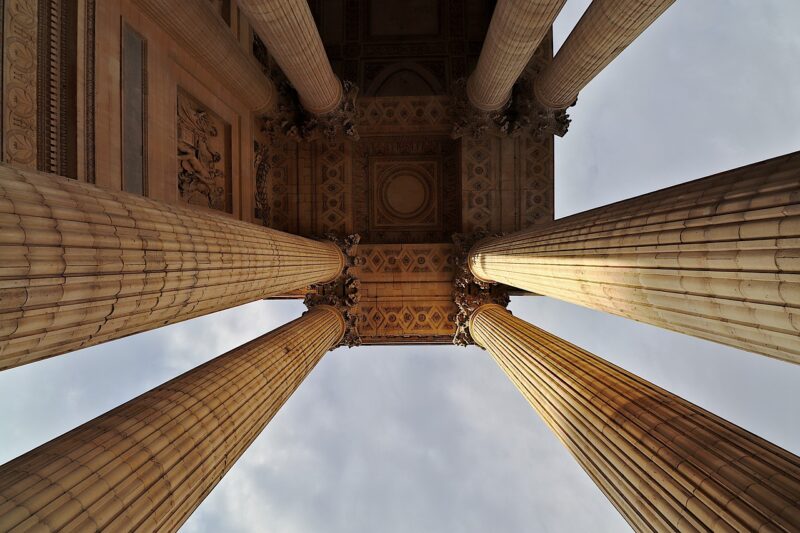The Pantheon, a testament to Rome’s architectural brilliance and historical grandeur, stands as one of the most well-preserved and influential structures from ancient times. Its rich history, innovative design, and enduring legacy make it a captivating subject for both historians and tourists alike.
Historical Background
Originally constructed in 27 B.C. by Marcus Agrippa, the Pantheon we see today was actually rebuilt by Emperor Hadrian around 120 A.D. This ancient edifice was designed as a temple for all Roman gods, symbolizing the unity and inclusiveness of the Roman religion. Its Latin inscription, “M·AGRIPPA·L·F·COS·TERTIUM·FECIT,” commemorates Agrippa’s original building, although Hadrian’s reconstruction greatly modified the design and scale.
Architectural Design
The Pantheon’s exterior is as imposing as it is elegant. The portico, with its 16 massive Corinthian columns, creates a grand entrance. These columns, each standing 39 feet tall and weighing 60 tons, were transported from Egypt, showcasing the Romans’ extensive reach and engineering capabilities.
The Dome
Perhaps the most iconic feature of the Pantheon is its dome, a marvel of ancient engineering. At 142 feet in diameter, it was the largest dome in the world for over a millennium. The oculus, a 27-foot-wide opening at the dome’s apex, serves not only as the sole source of natural light but also as a symbolic connection between the temple and the heavens. The dome’s coffered design reduces its weight without compromising strength, a pioneering technique in architecture.
Interior Design
Stepping inside, the Pantheon’s interior is a feast for the eyes. The rotunda’s circular floor plan, with its polished marble and intricate patterns, mirrors the dome’s perfect hemisphere above. Niches housing statues of gods and deified emperors line the walls, blending artistic elegance with religious reverence. The materials used, including various marbles from different regions of the Roman Empire, highlight the empire’s vast resources and the craftsmanship of Roman builders.
Religious Significance
Originally a pagan temple, the Pantheon was consecrated as a Christian church in the 7th century by Pope Boniface IV, dedicated to St. Mary and the Martyrs. This conversion helped preserve the building through the turbulent centuries that followed the fall of the Roman Empire. The Pantheon’s design influenced countless Christian structures, including the famous St. Peter’s Basilica in Vatican City.
Cultural Impact
The Pantheon’s influence extends far beyond its original religious purpose. During the Renaissance, it became a source of inspiration for architects like Brunelleschi and Michelangelo, who admired its perfect proportions and engineering prowess. Today, its design principles continue to inform modern architecture, exemplifying the timeless nature of its construction.
Pantheon in Modern Times
Today, the Pantheon serves both as a church and a major tourist attraction. Preservation efforts ensure that this ancient marvel remains intact for future generations. Visitors can experience the awe-inspiring structure firsthand, often accompanied by guided tours that delve into its rich history and architectural secrets.
Famous Burials
Among the notable figures buried in the Pantheon are the renowned artist Raphael and several Italian monarchs, including Victor Emmanuel II and Umberto I. These burials add another layer of historical significance, making the Pantheon not just a relic of ancient Rome but a monument of continuous importance through the ages.
Engineering Feats
The Pantheon’s construction is a testament to Roman engineering. Its dome, still the largest unreinforced concrete dome in the world, showcases the ingenuity and skill of Roman architects. Techniques such as the use of lightweight pumice in the upper levels of the dome and the integration of relieving arches in the walls exemplify their innovative approach to building.
The Pantheon’s Influence
The Pantheon’s design has inspired numerous structures worldwide, from the Panthéon in Paris to the Jefferson Memorial in Washington, D.C. Its architectural principles, particularly the use of the oculus and the harmonious proportions, have left an indelible mark on architectural history.
Visitor Information
For those planning a visit, the Pantheon is open daily with extended hours during the summer months. Early morning or late afternoon visits are recommended to avoid crowds. In addition to self-guided tours, there are numerous guided tours available that provide in-depth historical context and architectural insights. Nearby attractions include Piazza Navona and the Trevi Fountain, making it easy to explore Rome’s rich history.
Preservation Efforts
Maintaining the Pantheon poses significant challenges due to its age and the sheer number of visitors. Conservation projects are ongoing, focusing on both structural integrity and aesthetic preservation. These efforts are crucial to ensure that this architectural masterpiece can be appreciated for generations to come.
Pantheon in Popular Culture
The Pantheon’s grandeur has captured the imagination of many, appearing in numerous works of literature, film, and art. Its iconic design symbolizes the enduring legacy of ancient Rome and serves as a backdrop for exploring themes of eternity and divinity.
Conclusion
The Pantheon stands as a beacon of architectural brilliance and historical significance. Its innovative design, cultural impact, and continuous use make it a unique landmark in human history. Whether admired for its engineering feats, its religious significance, or its sheer beauty, the Pantheon remains an eternal marvel that continues to inspire awe and admiration.
FAQs
Who is buried in the Pantheon?
Notable burials include the artist Raphael and Italian monarchs Victor Emmanuel II and Umberto I.
What is the Pantheon used for today?
The Pantheon is currently used as a Catholic church and a major tourist attraction.
Who built the Pantheon?
The original Pantheon was built by Marcus Agrippa, but the current structure was rebuilt by Emperor Hadrian.
What is the Pantheon’s dome made of?
The dome is made of concrete, with the upper levels incorporating lightweight pumice to reduce weight.
Why is the Pantheon’s oculus important?
The oculus serves as the main source of natural light and symbolizes the connection between the temple and the heavens.









